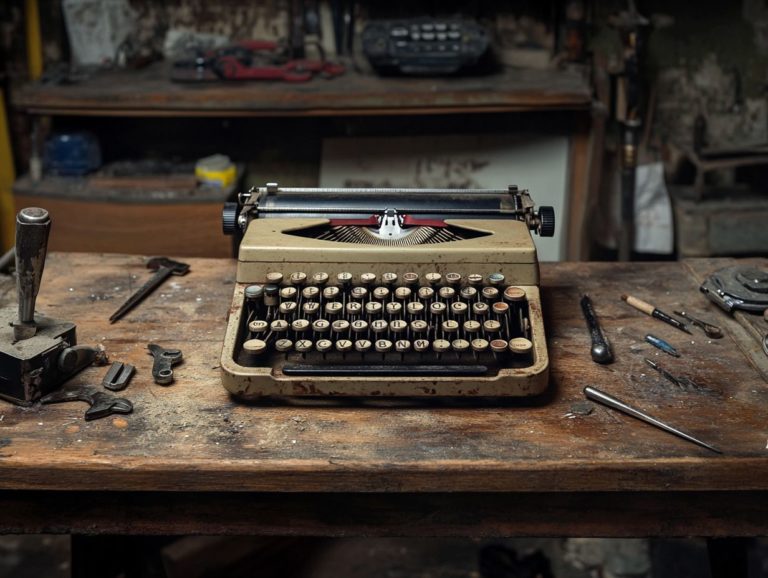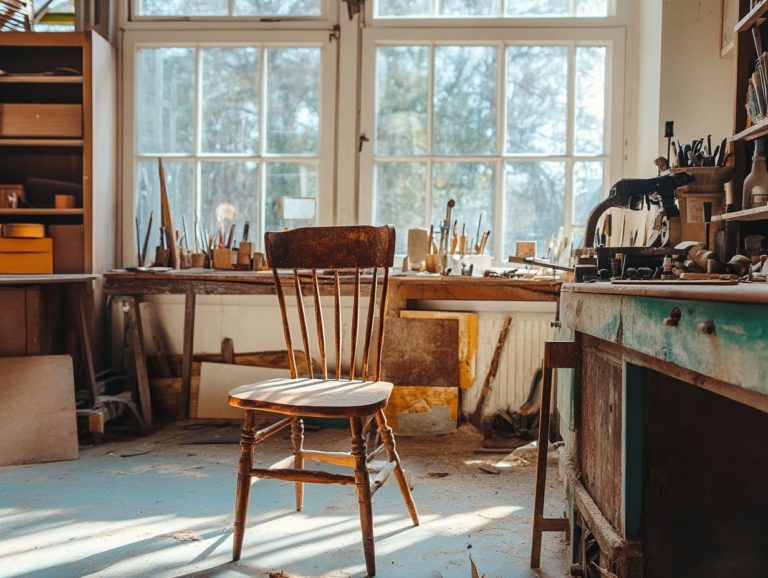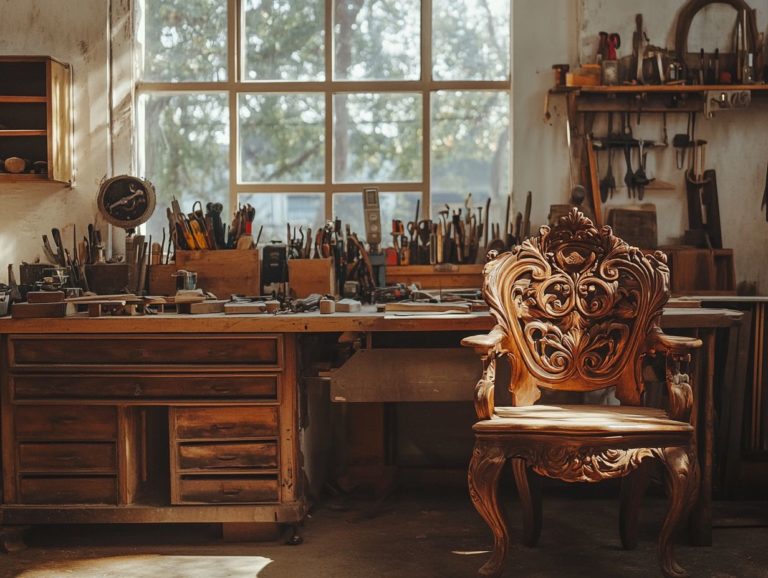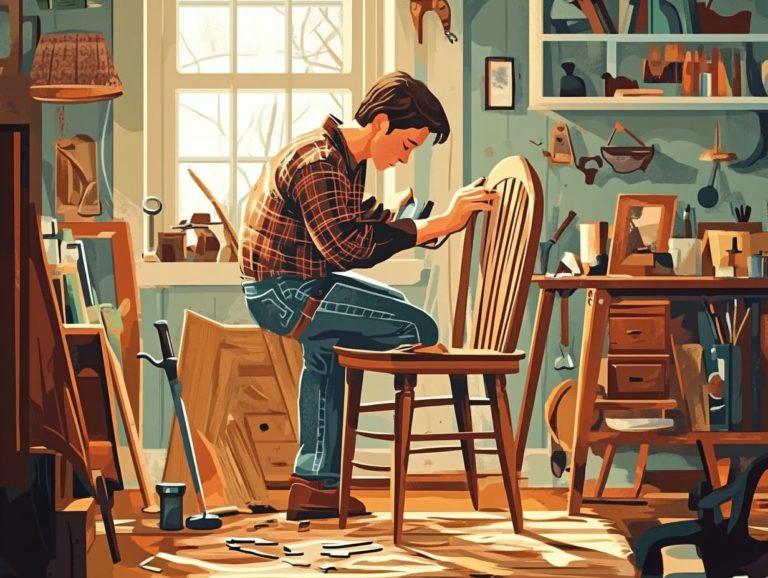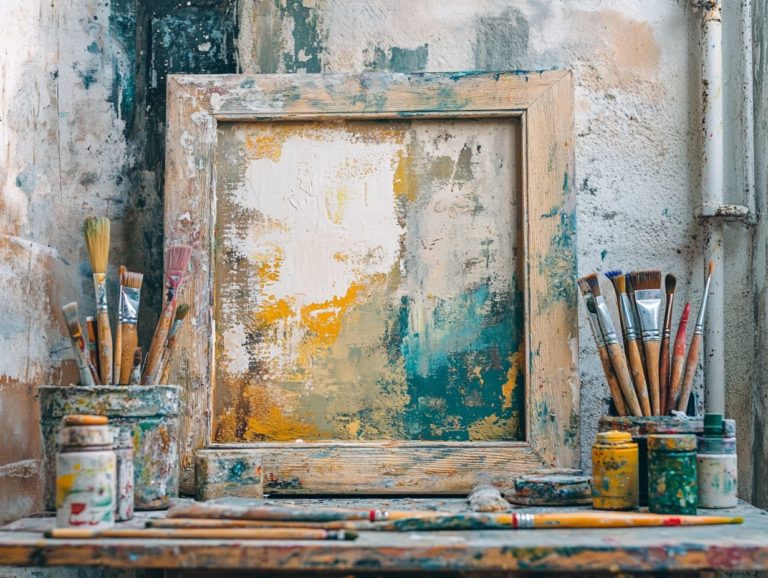5 Tips for Reviving Vintage Kitchenware
Reviving vintage kitchenware transcends mere trendiness; it s an opportunity to infuse cherished pieces with renewed vitality. Each piece holds its own rich stories and unique charm.
You ll uncover five essential tips to clean, repair, and elegantly showcase your beloved items, transforming them into functional art within your kitchen.
By grasping their true value and steering clear of common pitfalls, you ll absolutely love the myriad benefits and joys of incorporating vintage treasures into your culinary space.
Prepare to embrace the character and nostalgia that vintage kitchenware brings to your home!
Contents
- Key Takeaways:
- 1. Clean and Sanitize the Kitchenware
- 2. Repair Any Damage
- 3. Restore the Shine and Luster
- 4. Display and Use Them in Your Kitchen
- 5. Proper Storage and Maintenance
- What Are the Benefits of Using Vintage Kitchenware?
- Frequently Asked Questions
- 1. Why is it important to properly revive vintage kitchenware?
- 2. What are the best materials to use when reviving vintage kitchenware?
- 3. How can I remove rust from vintage kitchenware?
- 4. What is the best way to remove stubborn stains from vintage kitchenware?
- 5. How can I safely restore the shine of vintage silverware?
- 6. What is the best way to store revived vintage kitchenware?
Key Takeaways:
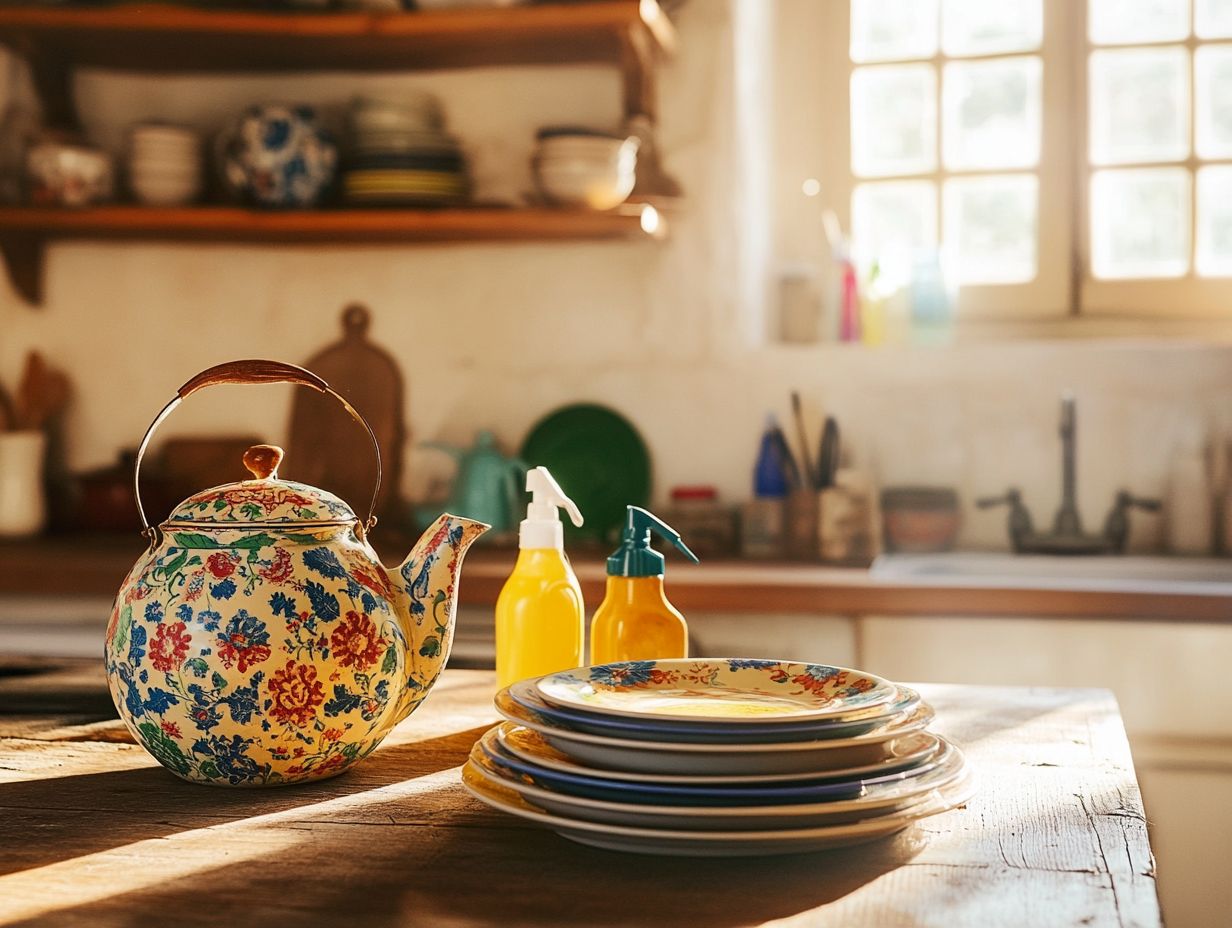
- Restore the shine and luster of vintage kitchenware to make them look as good as new.
- Display and use vintage kitchenware in your kitchen to add character and charm.
- Proper storage and maintenance of vintage kitchenware can help preserve its value and extend its lifespan, ensuring they remain part of your ‘buy it for life’ approach.
1. Clean and Sanitize the Kitchenware
Cleaning and sanitizing vintage kitchenware is essential for preserving the integrity and charm of these special items. This ensures they not only dazzle in your kitchen but are also safe for your culinary endeavors.
Many vintage kitchenware pieces, like Pyrex dishes and charming toasters, require a bit of special attention to maintain their unique characteristics and extend their lifespan. This allows you to revel in their beauty and functionality for years to come.
You can achieve this by using gentle cleaning techniques. For instance, Bar Keepers Friend can help restore the luster of tarnished metal surfaces without leaving a scratch. Meanwhile, WD-40 works wonders for rusting and can assist in repairing chipped enamel.
Soaking your vintage finds in a vinegar and baking soda solution can work miracles on tough stains. Regular maintenance, such as handwashing instead of tossing them in the dishwasher, helps enhance the longevity of these beloved pieces.
Swiftly addressing any signs of wear or rusting is also vital. Ultimately, a little TLC (Tender Loving Care) goes a long way in keeping your vintage kitchenware both functional and visually stunning.
2. Repair Any Damage
Repairing damage to vintage kitchenware is essential, not just to maintain their aesthetic appeal but also to ensure they remain functional and safe for everyday use.
By tackling tasks like enamel repair on MagicChef stoves or restoring the wood on vintage kitchen cabinets, you can breathe new life into these cherished items. Embracing a ‘buy it for life’ philosophy in your home is a rewarding approach.
As you restore the beauty of these appliances, be aware of common types of damage that can accumulate over the years. Chipping, rust, and fading are frequent issues on enamel surfaces, while wood furniture might suffer from scratches or water stains.
For effective enamel repair, consider using specialized touch-up paint or epoxy. Make sure to follow the manufacturer s instructions for the best results.
Wood restoration can be accomplished through sanding and refinishing techniques, applying a suitable stain or sealer to revive the natural grain. Sourcing replacement parts online or exploring DIY techniques can reveal innovative ways to restore functionality without sacrificing that vintage charm you love.
3. Restore the Shine and Luster
Restoring the shine and luster of vintage kitchenware is a truly rewarding endeavor. It not only enhances their visual appeal but also reaffirms their cherished place in your home.
Techniques like using Cream of Tartar for polishing vintage refrigerators and toasters will help you achieve a showroom finish while maintaining the integrity of these beloved items.
This process begins with a thorough cleaning to banish grime and grease. For metal parts, a gentle scrub with baking soda and vinegar can work wonders, effectively removing stubborn stains without risking damage.
When tackling more delicate surfaces, such as chrome finishes, a specialized metal polish designed for appliances yields impressive results. The transformation of a dull KitchenAid mixer can be astonishing!
After a careful restoration process, it will shine like new, making all that effort well worth it. With before-and-after visuals, the drastic improvement showcases the true value of preserving these nostalgic pieces in your kitchen.
Share your own vintage finds or restoration stories with us! Start your vintage restoration journey today!
4. Display and Use Them in Your Kitchen
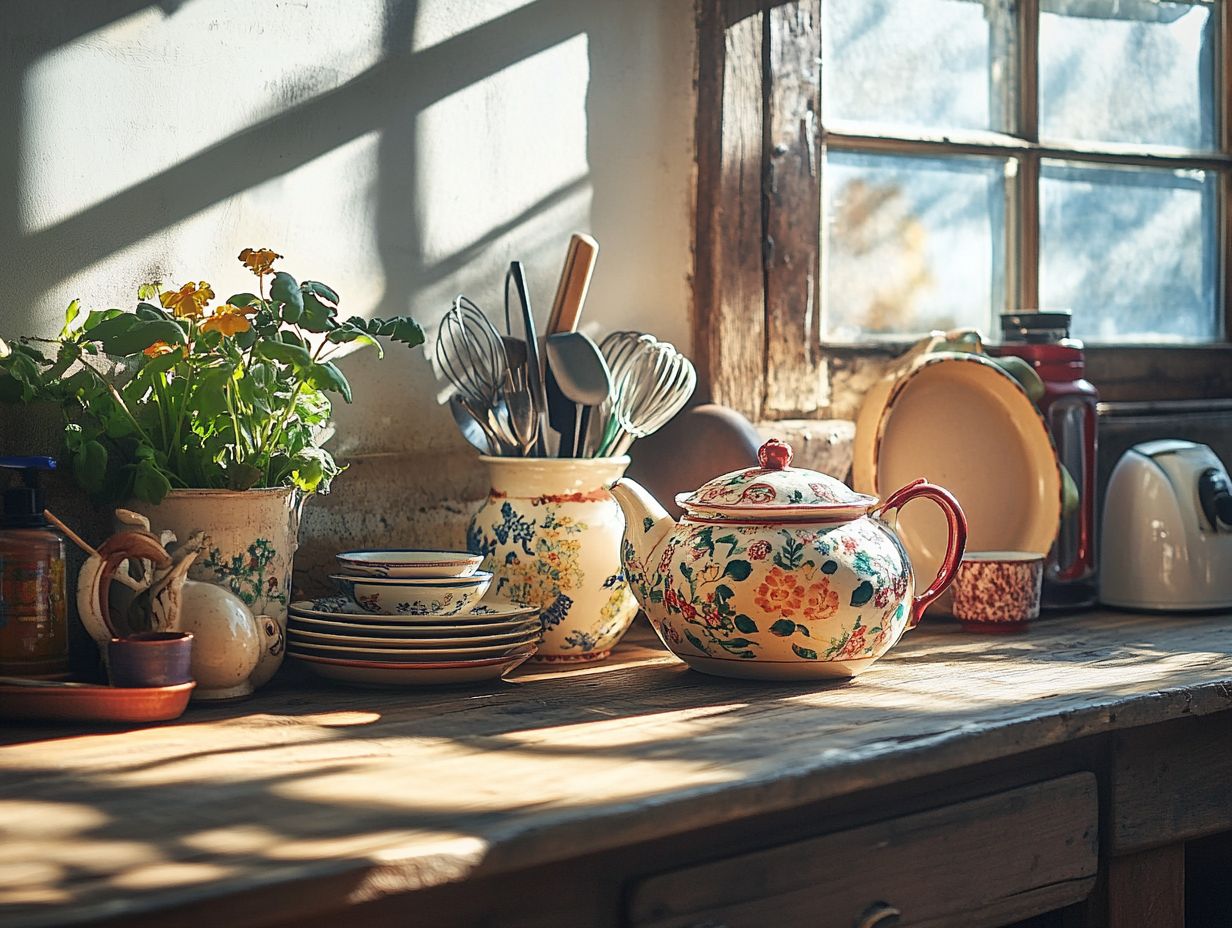
Displaying vintage kitchenware can transform your kitchen into a nostalgic haven. Unique pieces like a KitchenAid mixer or vibrant Pyrex dishes each tell a story of culinary history.
By arranging these items thoughtfully, you create an inviting atmosphere. This celebrates the charm and functionality of each piece while inspiring creativity in the kitchen.
Group items by color or style to craft visually stunning displays on your shelves. For example, mix cheerful floral ceramics with sleek, retro glass bowls to create a dynamic focal point.
Use these treasures as functional decor. Hanging colorful enamelware pots and pans blends aesthetics with practicality.
Incorporating vintage kitchenware into your cooking routine elevates the dining experience. Well-loved measuring cups and charming serving platters add character to your space.
5. Proper Storage and Maintenance
Storing and maintaining vintage kitchenware is essential to preserve their beauty. This allows you to enjoy these timeless pieces for generations.
Whether found in antique shops or vintage outlets like eBay or Etsy, knowing how to care for them is key. It ensures they remain in excellent condition for your culinary adventures.
Consider the storage environment. Keep humidity levels between 30-50% to prevent rust and mold, especially for metal items.
Select cool, dark spaces away from direct sunlight. Sun exposure can fade colors and damage finishes.
Use protective measures like padded containers or acid-free tissue to safeguard fragile pieces. Regularly clean surfaces with gentle, non-abrasive products to maintain their integrity.
Tailor care routines based on the type of appliance. For example, oil wooden utensils or check seals on vintage mixers to enhance longevity.
What Are the Benefits of Using Vintage Kitchenware?
Using vintage kitchenware brings a wealth of benefits. It transforms your cooking experience while adding character and charm to your kitchen.
These items often showcase superior craftsmanship. They embody a ‘buy it for life’ philosophy that champions sustainability and mindful consumption.
Vintage pieces elevate food presentation with distinctive designs. Many tools come with proven designs that make cooking and baking enjoyable.
Incorporating these artifacts connects you to the past. It reflects traditions crafted with love and meticulous attention to detail.
Choosing vintage kitchenware supports a sustainable lifestyle. It also reduces reliance on fast fashion, promoting eco-conscious choices.
These treasures are testaments to history. They enhance your culinary creativity and ensure your kitchen tells a unique story.
How Can You Identify the Value of Vintage Kitchenware?
Mastering the art of valuing vintage kitchenware is essential for collectors and enthusiasts alike. Understanding brand reputation, rarity, condition, and historical significance can greatly influence your purchases, especially for sought-after items like Pyrex.
To effectively assess the worth of these treasures, pay close attention to details like patterns, colors, and any flaws from production that might catch a buyer s eye. Staying informed about current market trends is vital; for example, certain colors or designs may suddenly gain popularity, causing their value to soar.
Familiarizing yourself with notable brands like Fire-King, Hall, and Fiesta can enhance your ability to spot worthwhile investments. Use online resources like auction sites and specialized communities to gain valuable insights into pricing, helping you make savvy choices as you navigate the exhilarating world of vintage kitchenware.
What Are the Different Types of Vintage Kitchenware?

Vintage kitchenware includes a wide range of items. From iconic appliances like the KitchenAid mixer to classic cooking ranges such as the MagicChef stove, each piece tells a unique story and offers distinct features that resonate with enthusiasts and collectors.
Take ceramic dinnerware sets from renowned brands like Hall China and Fiesta. They are celebrated for their vibrant colors and durability, boasting a timeless design that traces back to the 1920s.
Then there’s enamelware, often crafted by L.W. Smith, which exudes rustic charm with its bold colors and classic speckled finish. Don t overlook old-fashioned cast iron cookware, like skillets and Dutch ovens from Lodge. Their unparalleled heat retention and versatility in cooking make them highly sought after.
Collectors often look for specific patterns and styles, enhancing the allure of these vintage gems while honoring their historical significance.
Where Can You Find Vintage Kitchenware?
Discovering vintage kitchenware is an exciting adventure! Explore antique stores, eBay, Etsy, and Facebook Marketplace to find pieces that not only tell a story but also enhance your culinary space.
Local flea markets offer a delightful atmosphere, where a little haggling might just land you fantastic deals just be sure to inspect items carefully for chips or wear. Estate sales can be true gold mines, especially if the previous owners had a passion for their kitchen tools; arriving early is your best bet for the finest selection.
If you prefer a more curated experience, specialty vintage shops often feature higher-quality items, though you should be ready for a heftier price tag. When browsing online, remember that patience is key. Setting alerts for specific keywords can help you snag coveted pieces, and being savvy about negotiation techniques is essential to ensure you don t overpay for that charming slice of history.
What Are Some Common Mistakes to Avoid When Reviving Vintage Kitchenware?
When reviving vintage kitchenware, it’s essential to avoid common mistakes that could cause irreversible damage. For example, using harsh cleaning agents can be detrimental, as can overlooking the specific maintenance needs of each piece.
One frequent misstep is assuming that modern cleaning solutions work for older materials. A friend once used a strong bleach solution on a delicate mid-century casserole dish and watched its vibrant glaze fade. It’s best to stick with gentle soap and water for routine cleaning.
Many also forget to test vintage items for stability before applying oils or waxes. This oversight can worsen existing issues.
By dedicating time to research each piece’s specific needs, you can avoid these pitfalls and enjoy your kitchenware with confidence. Consider exploring vintage items worth restoring yourself for a rewarding DIY project.
How Can Vintage Kitchenware Add Character and Charm to Your Kitchen?
Vintage kitchenware adds incredible character and charm to your kitchen, transforming it into a warm and inviting space that reflects your unique personality and style. The timeless appeal of these items aligns beautifully with the ‘buy it for life’ philosophy, promoting a sustainable approach to home decor while honoring the rich history behind each piece.
Incorporating vintage dishes, utensils, or even furniture evokes a sense of nostalgia and creates captivating conversation starters for guests. To seamlessly blend vintage and modern elements, pair sleek, contemporary cabinetry with a delightful display of vintage tableware.
Choose a few standout vintage pieces like a retro coffee grinder or vibrant canisters and use them as focal points against a minimalist backdrop. These unique items often spark delightful stories and cherished memories, enriching your kitchen with layers of meaning and inviting shared experiences among family and friends. Consider incorporating 5 tips for upcycling vintage fabrics in decor to enhance your style further.
Frequently Asked Questions

1. Why is it important to properly revive vintage kitchenware?
Vintage kitchenware carries historical and sentimental value. Properly reviving these pieces preserves their unique look and ensures their longevity for future generations.
2. What are the best materials to use when reviving vintage kitchenware?
For cleaning and polishing, opt for gentle materials such as white vinegar, baking soda, and soft cloths. Avoid rough chemicals and materials that can damage the surface of the vintage kitchenware.
3. How can I remove rust from vintage kitchenware?
Mix equal parts white vinegar and water, then soak the rusted area for several hours. Gently scrub with a soft cloth or toothbrush. For tougher rust, use a paste of baking soda and water and let it sit before scrubbing.
4. What is the best way to remove stubborn stains from vintage kitchenware?
For stains on enamel or porcelain, mix cream of tartar with water to create a paste and gently scrub the stain. For metal or copper, lemon juice and salt can help. Always test a small area first before applying to the entire piece.
5. How can I safely restore the shine of vintage silverware?
Create a paste with baking soda and water and gently rub it onto the silverware. Rinse and dry thoroughly. For heavily tarnished silverware, try a silver polish specifically designed for antique pieces.
6. What is the best way to store revived vintage kitchenware?
Store vintage kitchenware in a dry, cool place away from direct sunlight. Use individual storage bags or wrap each piece in acid-free tissue paper to prevent scratching or damage.
Ready to bring your vintage kitchenware back to life? Start your restoration journey today!

